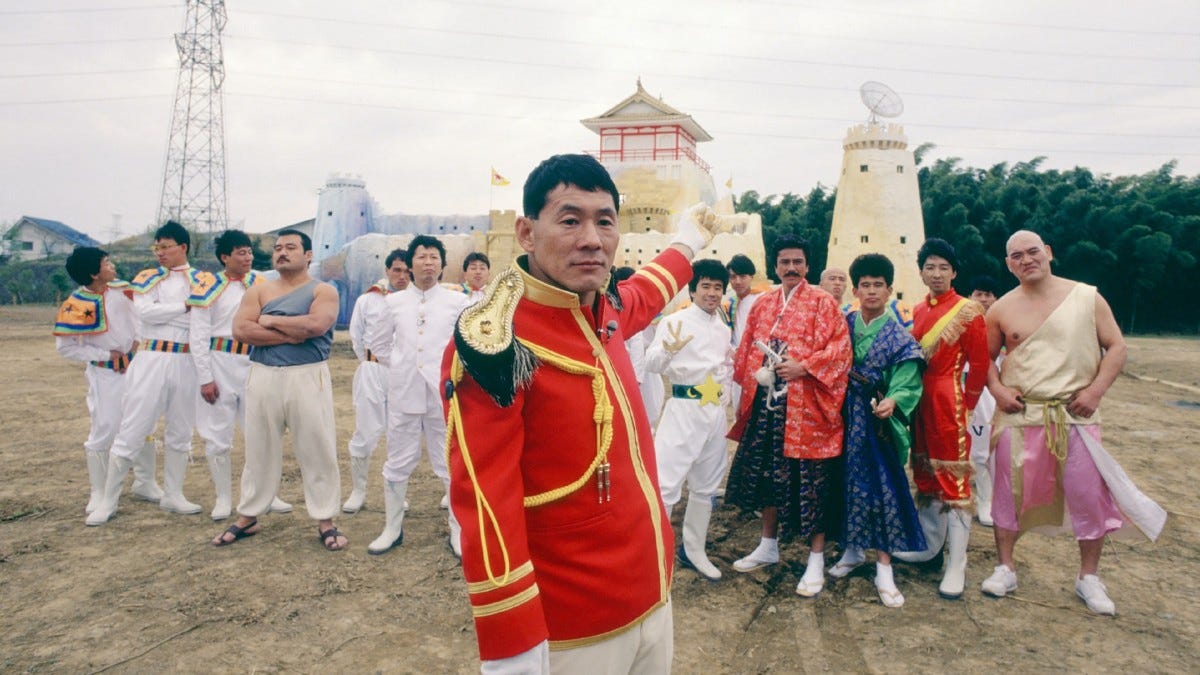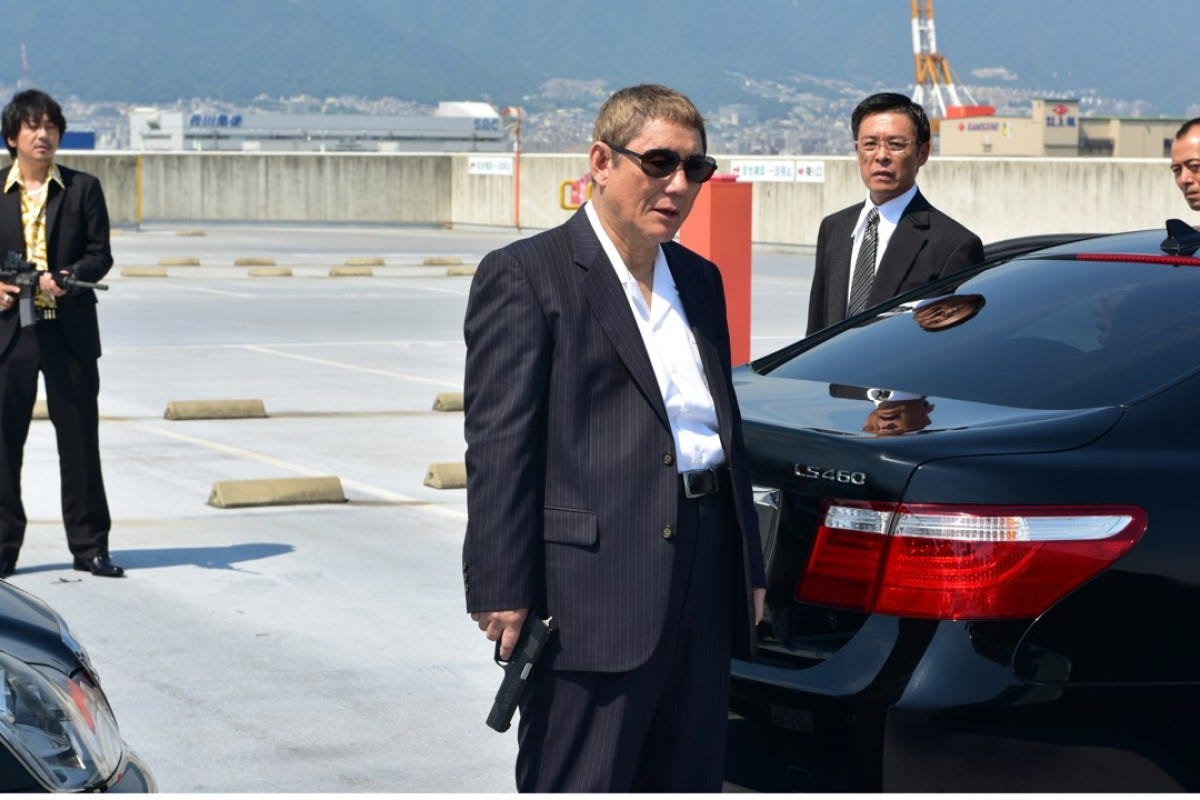This is a re-post from my old blog Coffee Fueled Film Rambles.
I’ve often been fascinated by the filters and barriers through which we first get exposed to what was once called foreign film culture. Often, the interventions of western producers of film and television to make international entertainment more “palatable,” and thus profitable, to English speaking audiences is to cleverly elide over all of its initial national context. The language and cultural minutia which would act as a dead giveaway for its country of origin are sanded off or carpeted over by things familiar to our experience in the West. For a famous example and meme, look no further than the dubbed release of Pokemon licensed by 4Kids Entertainment (a repeat offender of this crime) wherein a traditional Rice Ball or Onigri is referred to as a “Jelly Donut”.
This practice has existed for as long as distributors of international films have wanted to make a quick buck off someone else’s work and given too much free reign when it came to the products they licensed. Undoubtedly, this “internationalization” of foreign entertainment hit its peak in the late 1990s to early 2000s with the television anime boom and the rise of globalized soft-power known as ‘Cool Japan” that initially brought over Pokemon as a quick sell to impressionable kids and inadvertently created a dedicated western market for all future anime production. Plenty has been written on this cultural-economic exchange and this piece isn’t exactly breaking new ground through pointing it out. Instead, I want to reflect on a personal memory of mine related to this phenomenon and explore how I came to know one of the most important figures of contemporary Japanese cinema through the most embarrassing channel imaginable.
Let’s step back in time to the early aughts for a second. If you can recall this simpler time when there was an apparent high-demand for “guy centric programming” in the supposed effeminized landscape of cable television, you should also recall that Viacom answered these alleged requests for television exclusively for men by launching Spike TV in 2003. Advertised as shot of pure beer swilling, woman ogling testosterone into your cable box and as the “no girls allowed” channel, Spike TV courted a young and impressionable male demographic with crude comedies, sports coverage, edgy cartoons, and that rugged kind of reality show about working class joes like mechanics and exterminators, not Bachelorettes or Kardashians. If you could imagine a whole network run by Al Bundy’s NO MA’AM group from Married…With Children, you get the picture of what Spike TV was in the early aughts.
While “The First Network for MEN” is utterly embarrassing in hindsight, the channel understandably did well with its targeted 18-34 demographic…of which I was rather close to in the mid-aughts. While I was never a sports person and their reality shows left me more bored than invested, one show did indeed work on me enough to keep me tuned in. This was the flagship program and unexpected hit “created” by Paul Abeyta, Peter Kaikko, and Larry Strawther known as MXC: Most eXtreme Elimination Challenge. A progenitor to the popular ABC series Wipeout, the show featured two teams who would compete in bizarre, painful, and degrading obstacle courses/challenges all while two riffing commentators would berate them and squeeze as many jokes as they could into each spill and fumble. Having never grew up with a Double Dare or a Legends of the Hidden Temple, I was completely enamored with what I had thought at the time was a unique piece of entertainment I had never seen before.
Obviously, I couldn’t be more wrong in more ways, as MXC represents the “americanized” version of the popular and influential gameshow Takeshi’s Castle, broadcast by the Tokyo Broadcasting System between 1986 and 1990. Having licensed the large tape archive for Takeshi’s Castle, the MXC crew took the kernel of entertainment that crosses all international borders that is people getting hurt in comedic ways, and presented it to a new audience with some added immature humour jammed into the formula for good measure. The footage was relatively intact (although obstacle courses and events were spliced to hell and back to fill out an episode length) and all the appeal came from the writers inserting as many double entendres and pop cultural references as they could into each contestants failed attempt to conquer each “hilariously named” obstacle course (a challenge of running across large rollers called “Log Drop,” a calligraphy challenge called “Skid Markers,” a sumo challenge called “Circle Jerkers,” a dodgeball challenge called “Brass Balls,” you get the idea). Lacking any attempt to match the rapid-fire ribald commentary of hosts Vic Romano and Kenny Blankenship (voiced by Victor Wilson and Chris Darga) to their clearly Japanese counterparts, the show was a curiosity I would have more than likely forgot about once I left my immature teen years behind me.
Unfortunately for me, I developed an interest in Japanese cinema around the time I turned 16, and this interest has only progressed and intensified since that time. This is where the wires finally cross in this personal memory and I have to admit the first time I ever laid eyes on comedian, actor extraordinaire, and auteur director Takeshi Kitano was when some two-bit comedian was using him as a mouthpiece for dick jokes. Before I ever knew him under that name or his more popular comedian moniker Beat Takeshi, a man who it is no hyperbole to say changed the face of the Japanese film industry and the global opinion on Japan’s national cinema through his work in the 1990s and into the 2000s…to me he was Vic Romano.
I can’t recall the exact moment the revelation hit me that one of my favourite directors was introduced to me in the vulgar persona of MXC host Vic Romano berating injured contestants who fell off obstacle course, but I can tell it was one of the most eye-opening experiences of my life. Like a switch deep within the hazy recesses of my brain where I store all the garbage television I voraciously consumed suddenly flicked on and four seasons of a show I barely remembered came roaring back to me.
Outside of MXC (what a statement!), I knew Kitano primarily through his directorial efforts as one of the most bankable Japanese film exports after the unprecedented success of Hana-bi (1998) on the festival circuit, an event which reopened interest to Western distributors to Japanese film not unlike Kurosawa’s Rashomon did 48 years prior. The first film I saw by him was his faithful yet poignant reinterpretation of the Zatoichi film series in 2003, where he played the titular blind swordsman in a tour de force performance of sustained irreverence and sudden violence. A film of subtle imagination and arthouse sensibilities bookending an exhilarating chambara throwback, I knew instantaneously from this viewing experience that Kitano was just inarguably doing something different from his contemporaries, even from the small sampling size of said contemporaries I had at the time. A steadfast minimalist aesthetic and bizarre, at times tonally incongruent plays to humour that risks erupting into shocking violence at any second, he was a filmmaker that kept me on edge and invested in whatever turn his film could potentially take.
From his stripped down and brutal crime sagas in Violent Cop (1989) and Boiling Point (1990) to his reflective and soul-searching crime sagas in Hana-bi and Sonatine (1993). From his irreverent self-reflexive comedies in Getting Any? (1995) and Takeshis’ (2005) to his straightforward Yakuza epic in the Outrage Trilogy (2010-2017). In my perusal of his filmography, rarely was there a Kitano-directed film I didn’t immediately appreciate for its eccentricities or felt spoke to me on a specific wavelength upon viewing for the first time. To me, he was the immutable personality and uncompromising visionary that always came through no matter the subject of the film he was making or whether or not he had a presence in front of the camera. There was/is no mistaking a Kitano film.
So, I have always found it amusing that this figure of Japanese cinema that has meant so much to the concept of transnational cinema, globalized film culture, and to me on a personal level as an immense admirer of his work was himself an unknowing product of Japanese media being “americanized” for unsuspecting westerners, i,e me. Much like the jelly donut/rice balls that opened this personal account of film culture in translation, Vic Romano/Takeshi Kitano has always had a bizarre dual existence in my head for such an important figure with such a legacy (personal and otherwise) I thought I should put it into words. Originally this was going to be a confession-type post of a “bad cinephile” because I didn’t first discover Kitano in some independent arthouse cinema like a good cinephile should, I guess? I realized midway through composing this that perspective makes no sense. Who cares where we first uncover foreign film culture in all the forms it takes in transit? Why is it my fault some jackass at Spike TV thought he could make money off of Takeshi Kitano’s cult hit gameshow by dubbing over the great actor/director to say “scrotum” like a 13 year old?
This piece is more an observation of what gets lost in deliberately misleading translation I suppose, and a sigh of relief that we are far removed form this period where distributors were given a little too much creative control. Do you recall that lovely (possibly apocryphal) anecdote of Hayao Miyazaki mailing a samurai sword to scumbag Miramax producer and rapist Harvey Weinstein warning him off of tampering with Princess Mononoke upcoming American release with note saying “No cuts”? I’m doubtful that Kitano would have the same ire for Paul Abeyta, Peter Kaikko, and Larry Strawther for their hefty tampering with Takeshi’s Castle to pull such a stunt because at the end of the day, Kitano was first and foremost a ribald comedian who loved him some juvenile humour from time to time (I highly recommend the puerile, scatological, and awkwardly erotic Getting Any? for this). I am mostly just glad we live in a post-samurai sword mailing film world when we observe the integrity of international films instead of cutting them to ribbons and inserting dick jokes where you can.








